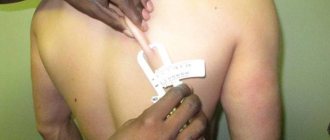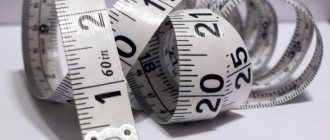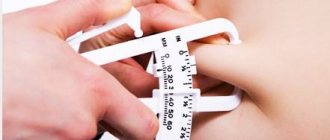How much body fat should you have?
Previously, men (and even some women) set their main goal to build muscles. But times are changing and now the main thing is “lean” mass, namely getting rid of fat mass in order to maximize muscle manifestation. Just think of Brad Pitt in Fight Club or Cristiano Ronaldo at any point in the last ten years. Pronounced muscles, not fat tissue.
A similar figure - lean body mass, without excess deposits - has recently become the main goal of trainers and gym visitors. But even if you are not striving for such pronounced muscles, it is worth finding out what percentage of body fat is normal and whether you need to change it, since this amount is one of the main indicators of the health of the body.
“Having a normal percentage of body fat reduces the risk of developing a variety of diseases,” explains Dr Luke Powles from Bupa's Crossrail Medical Center in London.
“Higher body fat has been shown time and time again to increase cholesterol and blood pressure, both of which are risk factors for cardiovascular disease. This condition can also cause certain types of cancer and diabetes. In men, high body fat leads to erectile dysfunction.
But the percentage of body fat to muscle mass should not be too low, since underweight also leads to the development of a number of diseases.”
How much fat should you ideally have? For men aged 20-39 years old, the norm of body fat varies from 8 to 20%, for men aged 40-59 – from 11 to 22%. Now it’s much easier to find out your body fat percentage: smart scales, pocket scanners and fitness trackers can easily provide all the information about your body composition. For conservatives (or budget-conscious) there is also an option - a caliper.
Before you start losing fat, it's worth learning a little about the biological processes behind it. Let's start with the two types of fat: essential and stored.
Low fat percentage or negative energy balance?
There are studies that show that a low percentage of fat does not in any way affect the absence of menstruation and the appearance of amenorrhea in girls. It's all about negative energy balance, not fat percentage per se. When a girl begins to lose weight and lose her kilograms, she does this due to a calorie deficit , that is, she spends more energy than she receives from food, thereby creating a negative energy balance .
So, it is this factor that is key in stopping menstruation and disrupting a girl’s reproductive function, and not the low percentage of fat itself.
If you believe these studies, it turns out that, in principle, a girl can have 6 packs on her stomach and not have problems with her cycle. Is it really?
- How to pump up your abs to six-pack size without harming your health? Part 1: Basic Physiology
If we think logically, then in order to get the desired muscle definition, you simply NEED TO REDUCE your fat component, that is, REDUCE the percentage of fat in the body to its minimum (13-14%). And this, in turn, can ONLY be done thanks to a calorie deficit , which is created by reducing the number of calories ingested from food and increasing energy expenditure during training.
And here the question arises: are there girls who compete in the “Bikini Fitness” or “Body Fitness” nominations and at the same time their cycle does not disappear? How is this possible? After all, most of them bring their body fat percentage below the minimum acceptable norm of 13%.

I allow this option:
those girls who were able to maintain their menstrual cycle during drying and a strict diet (and there are not so many such girls), they still managed to maintain their energy balance at the proper level, without creating a large calorie deficit due to sports supplements nutrition and vitamin complexes.
- Sports nutrition and health: is it possible to put an equal sign between them? Part 1
After all, in order to prepare and compete in bodybuilding and bikini fitness competitions, you definitely need additional help in the form of special sports nutrition, otherwise there is no other way. Training and strict nutrition deplete the body’s energy reserves so much that sometimes girls not only lose their cycle, they simply faint right on stage. This all shows how illiterate and incorrectly the coach or the girl herself approaches the issue of preparation and preparation for competitions. It is clear that the diet of performing athletes contains the minimum possible amount of carbohydrates (the main source of energy), but, perhaps, some also do not receive the normal amount of proteins and fats from food. We cannot know this for sure, but it is true that sports nutrition supplements can partly reduce the energy balance created in the body of athletes.
Where am I leading with all this? And besides, if you want to have a low percentage of body fat (less than 15%) in order to see your six-pack on your stomach, you need to take this issue VERY seriously! Firstly, you need to find out your minimum percentage of fat with which your body continues to function normally, and secondly, do not forget about additional nutrition for athletes.
Remember that the level of fat in the female body is still directly related to the negative energy balance created. The higher it is, the faster you lose weight and reduce your fat percentage. And if at this time you do not help your body and do not support it in the form of additional sports nutrition and vitamins, then you risk losing your cycle, and subsequently getting even more problems with your health:

And there is one more important point that I would like to mention. After the girl fully realizes that her weight loss is not at all the result she dreamed of, and she decides to increase her fat percentage to her “historical” norm, then this girl will inevitably face the realities of her weight loss. Unfortunately, not all the consequences of this weight loss will go away as completely as they appeared. Yes, she will most likely be able to return her menstrual cycle to normal in a couple of weeks, but, for example, the loss of some minerals that are responsible for bone strength may be an irreversible process for her. The consequences of amenorrhea never go completely without a trace, this is a scientifically proven fact. So, keep this in mind if you suddenly want to lose weight and reduce your normal body fat percentage to a minimum.
Accumulated fat
Another type - accumulated - is the result of excess calories consumed. When we eat, calories that are not immediately used for functioning (such as providing energy for breathing or maintaining heart rate) are converted into triglycerides, which make up stored fat. Frequent excess calories, which cause fat accumulation, lead to weight gain. On the other hand, a repeated calorie deficit forces the body to use stored fat mass as energy, depleting reserves and leading to weight loss.
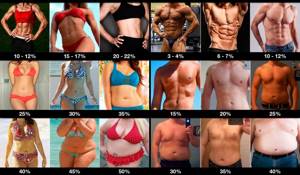
Comparison table of methods

You can calculate fat mass in the human body using one or another of the methods presented above. The arithmetic mean coincides with the calculation results.
comparison table
| US Navy method | 16,8% |
| Covert Bailey method | 17,0% |
| BMI method | 17,8% |
| YMCA method | 17,54% |
| Additional YMCA method | 18,1% |
| Average | 17,45% |
To find out your fat percentage, you don’t have to go to specialized clinics or medical centers. There are a huge variety of different methods, each of which can be used at home. All of the above methods guarantee accurate results if the instructions for implementation are followed.
Body fat percentage
Simply put, fat is unused energy that is life-threatening. Its percentage in the body is the ratio of fat mass to total body weight. Returning to the question of what percentage of fat a person should have in the body, it should be noted that this number is influenced by many factors, such as height, gender and heredity. A "healthy" percentage for men aged 20 to 40 is generally considered to be no less than 8% and no more than 20%. A healthy woman in the same age group should have a body fat percentage between 15% and 31%. These figures are based on November 2015 data from the Royal College of Nursing.
What is fat for?
You may be interested in:Additional ECG lead and key indicators of heart function - new items in the fitness bracelet option
Every body needs fat, but within the established norm. It performs the following functions:
- provides protection to internal organs;
- regulates body temperature;
- retains nutrients in the body;
- softens joints;
- provides energy storage.

Table of body fat percentage for men of different age groups
| Category | 20-39 years old | 40-59 years old | 60-79 years old |
| Low fat percentage | < 8% | < 11% | < 13% |
| Healthy body fat percentage | 8-20% | 11-22% | 13-25% |
| Increased fat percentage | 20-25% | 22-28% | 25-30% |
| High percentage of fat | > 25% | > 28% | > 30% |
Most people can be guided by these indicators, but it should be remembered that the table does not take into account everyone’s individual fitness goals. Bodybuilders typically aim for ultra-lean muscle mass and a body fat percentage of no more than 5-8%. Cyclists and gymnasts are among the leanest athletes and typically have between 5 and 12% body fat. In order to look as prominent as possible, the indicator should be from 5 to 10%.
Methods for measuring body fat percentage
There are several most popular methods that will allow you to determine the level of this parameter with comparative accuracy. The most progressive of them is bioimpedancemetry.
This method is performed using electronic pulses and other signals. A similar option would be to use special scales. They are based on the data entered and the resistance level.
Measurements can also be made manually. For example, having found out your exact parameters, you can substitute them into the finished formula. Also, using a caliper, you can determine the percentage of fat by “pinching” the skin. Here, too, it will be necessary to carry out some calculations.
There are many online calculators that will automatically display the required percentage.
BMI and body weight
Body fat percentage is the best indicator of health. It is better suited for determining the constitution than the aging body mass index (BMI) or simply weighing. Weight can vary significantly depending on hormonal fluctuations, time of day, and the amount of food eaten and drunk before stepping on the scale.
If you are very tall and have significant muscle mass, your BMI will likely put you in the overweight or even obese category. The problem is that BMI was developed in 1832 by Belgian mathematician Adolphe Quetelet to identify the average person (determining how weight increases with height), not to identify underweight or obesity.
In the 1980s, BMI was adopted as a useful tool for determining life expectancy, and has been the bane of muscular people ever since. BMI often prevents young people from joining the police and other fitness-oriented agencies because they still use this indicator for admission. However, by measuring your body fat percentage, you are measuring the amount of fat mass, rather than getting an estimate based solely on height and weight.
Source: https://www.coachmag.co.uk/exercises/lose-weight/3809/what-is-a-healthy-body-fat-percentage
Obesity
From 30 to 34% body fat is visually visible. Such data is characterized by the distribution of fat evenly throughout the body: on the neck, hips, arms, abdomen, back and face. If you look closely, visually the waist size seems much wider than the hip size, and the stomach seems to hang forward.
Between 35 and 39% body fat is achieved when body weight continues to increase. As a result, the percentage of fat in men also increases. The largest amount of fat deposits accumulates in the abdominal area, which begins to sag even more. The waist is no longer visible, as it is covered with fat, and the girth in this place can exceed 101 cm.
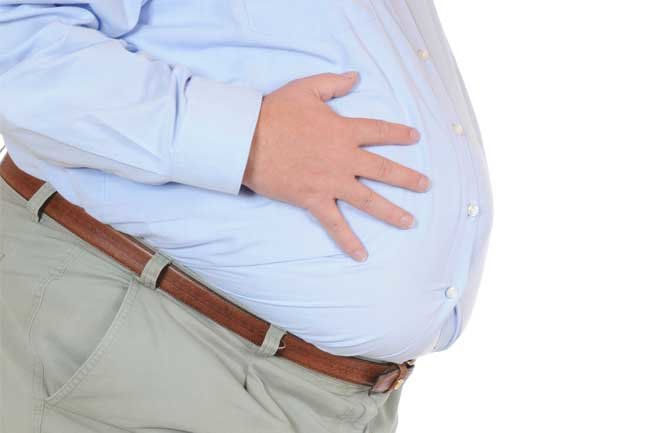
From 40% of the body fat content and more, as in the case described above, deposits are concentrated in the abdomen and estimated waist. The waist circumference already exceeds 145 cm. Similar indicators for a man - the percentage of fat and its voluminous shape - force him to face a number of difficulties in his usual life. For example, walking up the steps no longer seems so easy, or getting through the door is very difficult. It is almost impossible to bend over. This signals obesity. You need to consult a specialist or start eating healthy on your own, including physical exercise.
The amount of body fat in women
If it is normal for a man to have 8-12 percent body fat, then for women it is normal to have 12-20%, because a woman is by nature weaker and softer: she has less muscle and is covered with more fat.
This is how nature intended, but not all women agree with nature and therefore at fitness competitions, we can see women whose body fat percentage is less than 12%.

Create a program to reduce body fat mass
Visual representation of fat content in women
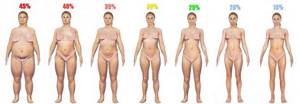

Fat content in women. Description.
10 – 12% fat content in women
This is an extremely low level of body fat that is found only in female bodybuilders. The minimum fat content in a woman’s body is 8–10%, while in men it is only 2%. Why is there such a big difference? The fact is that women contain more fat in the tissues of the mammary glands and in the area around the uterus. This level of fat is not considered normal for a woman and can be hazardous to health and can even cause menstruation to stop. The muscle grooves and blood vessels are clearly visible. The woman in the photo most likely has 12% body fat, as the vessels are not very visible.
15 – 17% fat content in women
This level of fat is also very low and equates to 6 – 7% body fat in men. Most lingerie models have exactly this level of body fat, and many of them have obvious problems with the functioning of the female body. The muscles of the abs, legs, arms and shoulders are clearly visible. The thighs and buttocks are usually less defined due to their low fat content.
20 – 22% fat content in women
This level is typical for many female athletes. The abdominal muscles are clearly visible, and there is some fat on the arms and legs. There is a level of separation between muscles, but it is minimal.
25% fat content in women
This is the level that most women have. Not too thin, but not too fat either. The curve of the hips is clearly visible, and there are small deposits of fat on the buttocks. A woman with a height of 163 cm and a weight of 59 kg has 25% body fat.
30% fat content in women
While men store fat in the abdominal area, most women store it in the thighs and buttocks. With this fat content, the hips are clearly defined and have a rounded shape. This is considered the limit of fat content for a normal woman.
35% fat content in women
The hips become even larger, and the face and neck have a rounded shape. The hip circumference can reach more than 100 cm, and the waist more than 80 cm. The stomach begins to droop.
40% fat content in women
Hips and buttocks become larger. The hips can reach more than 106 cm in circumference, the waist more than 90, and the hips more than 63 cm.
45% fat content in women
The skin loses its beauty and clearly visible folds appear. The hip circumference can reach more than 115 cm, and the waist more than 90 cm. The hips become noticeably wider than the shoulders.
How to estimate your body fat percentage
Relative content of adipose tissue in the body of women (in percent)
| Characteristic | Age, years | ||||
| 18-29 | 30-39 | 40-49 | 50-59 | >60 | |
| Very low | |||||
| Low | 16-19 | 17-20 | 18-21 | 19-22 | 20-23 |
| Optimal | 20-28 | 21-29 | 22-30 | 23-31 | 24-32 |
| Moderate high | 29-31 | 30-32 | 31-33 | 32-33 | 33-35 |
How to lose weight through sports?
Basic rules of training, diet and useful links in the material for those who want to learn how to lose weight correctly and reliably.
Relative content of adipose tissue in the body of men (in percent)
| Characteristic | Age, years | ||||
| 18-29 | 30-39 | 40-49 | 50-59 | >60 | |
| Very low | |||||
| Low | 11-13 | 12-14 | 14-16 | 15-17 | 16-18 |
| Optimal | 14-20 | 15-21 | 17-23 | 18-24 | 19-25 |
| Moderate high | 21-23 | 22-24 | 22-26 | 25-27 | 26-28 |



